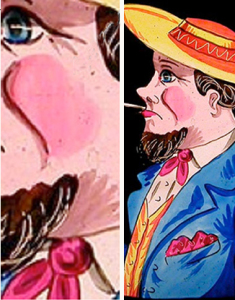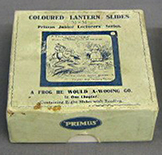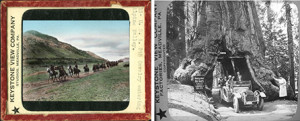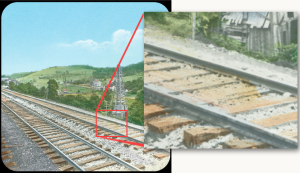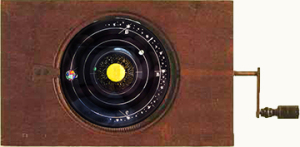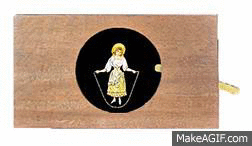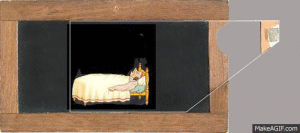The lantern slide has its origins in 17th century optical viewing devices which came to be known as “magic lanterns.” The earliest slides for magic lanterns consisted of hand-painted images on glass, projected by itinerant showmen telling stories about the images that were projected.
Hand Painted
They can be recognized by the simple paint areas applied with a brush and the obvious brush strokes.
Close-up hand painted areas, note continuous color laid down with brushed on darker color for shadows.
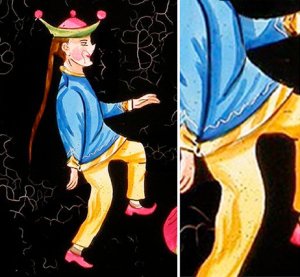
Printed Slides
Children’s toy magic lantern slides. Many made in Germany, and frequently are rectangular strips of glass of many sizes, with blue, green, red, orange, pink or yellow paper edging glued on so not to cut children’s hands. Slides are transfers or decals stuck onto the glass strips.
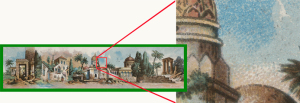 Commonly slides are listed as hand painted but in fact they are printed. With the improvements of printing techniques on glass, mass produced slides became possible. This type of transfer slide was produced in the many thousands over a period from the mid-1800s to the 1920s or so, and shipped all over the world. Hundreds, if not thousands, exist.
Commonly slides are listed as hand painted but in fact they are printed. With the improvements of printing techniques on glass, mass produced slides became possible. This type of transfer slide was produced in the many thousands over a period from the mid-1800s to the 1920s or so, and shipped all over the world. Hundreds, if not thousands, exist.
Decalcomania or Chromolitho Slides
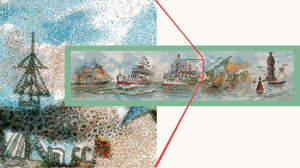 By the difficult term Decalcomania we describe the technique of transferring pictures from specially prepared paper to surfaces such as glass, china, pottery etc. In the world of magic lanterns we specifically mean the application of this process while making a lantern slide by transferring an image to a square or oblong piece of glass. The technique was used by professional slide makers, but enjoyed a vogue among amateurs too. Images were printed in colors by the chromo-litho principle, and then transfered to glass. Porous paper was coated with a solution of starch, albumen and glycerin. The colored pictures were printed, details first, background last, and then finished by a coat of glue.
By the difficult term Decalcomania we describe the technique of transferring pictures from specially prepared paper to surfaces such as glass, china, pottery etc. In the world of magic lanterns we specifically mean the application of this process while making a lantern slide by transferring an image to a square or oblong piece of glass. The technique was used by professional slide makers, but enjoyed a vogue among amateurs too. Images were printed in colors by the chromo-litho principle, and then transfered to glass. Porous paper was coated with a solution of starch, albumen and glycerin. The colored pictures were printed, details first, background last, and then finished by a coat of glue.
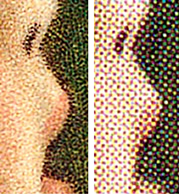 In this 10X enlargement you can really see how each hand-drawn dot in the chromo print (left) is uniquely different than the photo-mechanical ‘ruled’ dots in today’s modern 4-color offset prints (right image).
In this 10X enlargement you can really see how each hand-drawn dot in the chromo print (left) is uniquely different than the photo-mechanical ‘ruled’ dots in today’s modern 4-color offset prints (right image).
Photography Slides
The Langenheims first put a positive photographic image on glass in 1848; by the 1850s they were offering photographic slides commercially along with their glass stereoviews. Three and a quarter inches by four inches, are generally thought of as American size. If they are 3.25 inches square, then they are known as the British size. However, both sizes seem to have been produced in countries other than the United States and England. Most of these two sizes of slides consist of two sheets of glass, one of which has the image on one side of it and the other which covers the image, and bound all around by a black paper tape. Such slides were produced by black and white photography, and remain that way on many. If they are colored, it was necessary to hand color them, since color photography was not widely available during the peak production of this type slide.
Additionally, many popular slides produced in Europe were also transfer slides of children’s fairy or folk tales, such as Alice in Wonderland, John Gilpin’s Ride, Cinderella and so on. They were sold in boxed sets of eight to 12 or more, and covered more subjects than mentioned before. Such sets also came with what is referred to as a reading, or script describing the story slide by slide.
Slides From Drawings
Americans developed a technique for making slides that was rarely used elsewhere in the world: creating a master drawing, photographing it, and then printing slides.
Joseph Boggs Beale produced drawings to be reproduced as lantern slides.
He made more than 2000 drawings which were reproduced as magic lantern slides. His drawings, and the slides that were produced from them, covered an amazingly wide view of American life.
For more information on Joseph Boggs Beale click here.
Just one of the major producers of photographic slides was The Keystone View Company.
From 1892 to 1963, the Keystone View Company produced thousand of images of people and places from the United States and around the world. The photos are of historical, social, cultural, and geographic interest. In 1905 the Keystone View Company began its Educational Department, selling stereo views and glass lantern slides (the forerunner of the photo transparency, later used in slide projectors) to schools throughout the country. They also produced lantern slide projection equipment.
One of the methods to produce photo lantern slides was to make a contact glass copy from the original glass negative.
Hand Colored Black and White Slides
Many black and white slides are hand colored and are often listed as hand painted. These slides can have a very high quality hand coloring and be misidentified as hand painted.
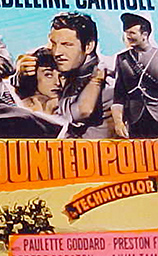
There were many mass produced hand colored slides that had a very quick color application as shown on left.
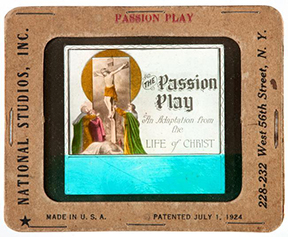 The American sized slides were produced in the hundreds of thousands, and covered just about every imaginable subject. Some American slides were called lightweight with only one piece of glass with a cover glass and framed in a light cardboard. They are, of course, more fragile and prone to scratching or other damage.
The American sized slides were produced in the hundreds of thousands, and covered just about every imaginable subject. Some American slides were called lightweight with only one piece of glass with a cover glass and framed in a light cardboard. They are, of course, more fragile and prone to scratching or other damage.
On eBay there are over six to eight thousand slides listed daily. One dealer alone has over sixty two thousand slides.
There were over six hundred producers listed in the incomplete society listing of slide producers and during a one hundred ninety year period, 1750 -1940, there were hundreds of thousands of slides produced.
Color Photographic
There were attempts to make colored photographic lantern slides with starch grains, but they did not survive in large numbers, and had a tendency to be somewhat fragile.
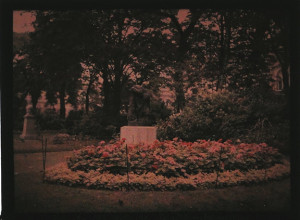 The Autochorome, more dense than other transparencies, was the first widespread transparent color process. There were five or six others developed in the first part of the twentieth century. All were inferior to the Kodak transparency film that came to market in the 1930s and rapidly displaced hand colored slides as the slide of choice.
The Autochorome, more dense than other transparencies, was the first widespread transparent color process. There were five or six others developed in the first part of the twentieth century. All were inferior to the Kodak transparency film that came to market in the 1930s and rapidly displaced hand colored slides as the slide of choice.
Mechanical Slides
Eventually, the magic lantern did more than just project images on a wall. By sliding two images over each other, effects could be obtained, like a sleeping man swallowing rats.
The desire to create moving images pushed the projectionist to devise ingenious mechanisms to archive basic moving pictures. These included using levers to move a second strip of painted glass over a fixed one, devising a rack and pinion for circular motion such as a windmills’ sails. For educational themes, the motion of the planets in orbit or a simulated eclipse of the sun could be created.
Lantern Slide Solar System
Click here to see Chromotrope slide in action
They called them by strange names such as glass pivot, single and double slipper, single and double lever, pivoted lever slide, double pulley, single and double rackwork, eccentric movement, roller blind, astronomical rackwork, brass acrobatic, and the Choreutoscope slide.
Single Lever
Slip Slides
Many early magic lantern slide devices contained some rudimentary form of movement. This usually involved a simple two-stage process. These particular slide transparencies consisted of two pieces of glass sandwiched together. The lantern operator would manually operate one glass on top of another. Since two separate, yet related images, were contained on the slides, the effect in the projected image was one of apparent movement.
Two glasses are mounted in a wood frame. The action is produced by moving one glass, the ‘slipping glass’, in front of the second glass, which is fixed thus creating movement. The slipping glass is free to move across in a lateral direction and can be pulled partly out of the frame, and pushed in to its former position.
Example of animated slip slides. Click image to see slip slide in action.
